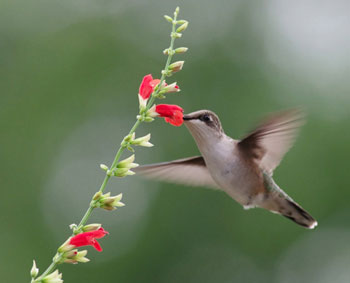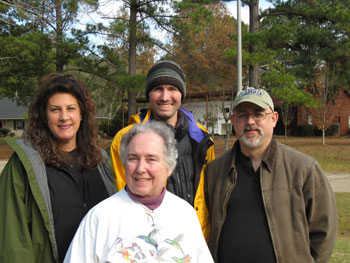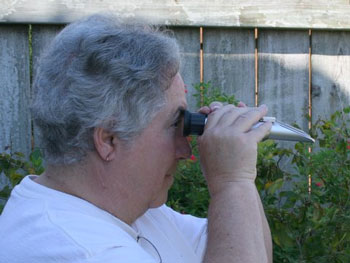Sage Experts: Nancy Newfield, Hummingbird Gardener, Part II

This is the second article in a 3-part series about Louisiana hummingbird researcher and wildlife gardener Nancy L. Newfield. Part I of the series delves into her childhood fascination with nature and contributions to research about hummingbirds.
More than 40 years ago and before she became a hummingbird expert, Nancy Newfield visited with a birding friend in her south Louisiana garden. Newfield recounts her introduction to hummingbird gardening in her 1996 book, Hummingbird Gardens, Attracting Nature's Jewels to Your Backyard, which she co-authored with Barbara Nielsen.
"Robert Raether planted sultan's turban, turk's cap and flowering maple… showing me the basics of using natural nectar sources to attract hummingbirds. In Louisiana's rich soil and subtropical climate, the plants flourished," Newfield wrote.
"As if by magic," she added, "a hummingbird arrived almost as soon as the first bud unfurled, although I had tried unsuccessfully to attract the birds with a feeder for more than a year. To my delight, that first hummer, a female ruby-throat, was followed by a succession of others that darted from blossom to blossom, twittering from dawn to dusk."
A Pleasant Surprise
Newfield expected to say goodbye to hummingbirds for the cold-weather season when fall migration began. Instead, she discovered that after the last Ruby-throated Hummingbird (Archilochus colubris) departed, other species remained -- a Rufous Hummingbird (Selasphorus rufus) and some Black-chinned Hummingbirds (Archilochus alexandri). They stayed through winter.

Front -- Nancy Newfield;
Back -- Joan Garvey, Stephen Locke
and Kevin Morgan
"This unexpected bonus convinced me that nectar-producing flowers could work far better than feeders in drawing hummingbirds," Newfield wrote, "and so I set a goal of having something in bloom for the birds throughout the year." She also began recording hummingbird visits and shortly learned how to band their tiny legs so she could track the overwintering phenomenon from year to year.
A Careful Observer
Newfield writes colorfully and carefully about hummingbirds. Flowers by the Sea is pleased to present an excerpt here from Hummingbird Gardens offering a historical perspective on hummingbird obsession with the color red. Another sidebar (10 Top Red Hot Hummingbird Garden Plants) lists some of the red hummingbird Salvias and companion plants available at FBTS.
What to Expect Next
The final story of this series, takes you to Louisiana for a hummingbird banding with Newfield's team of volunteer researchers better known as the Casa Colibrí (hummingbird house) Krewe. Part III also visits a Rufous Hummingbird's nest via YouTube and includes more favorite hummingbird plants from the our online nursery catalog.
Remember that we're always glad to answer questions about any FBTS plants, all of which we grow on our Northern California farm. Just give us a buzz us by telephone or email.
Hummingbirds work hard from sunrise to sundown to feed themselves and -- in the case of females -- their babies. They are attracted to high quality nectar rich in calories and nutrients. The better the nectar, the less energy they must expend finding food.
Due to their long thin beaks, they need to gather nectar from tubular flowers. Many Salvias and their companion plants fit the bill.
Although the best hummingbird flowers come in many colors, red gets top attention. For a detailed explanation of this phenomenon, please read Seeing Red and Loving It: Hummingbirds and Salvia Microphylla.
The following list contains plants from Flowers by the Sea to try in many regions of the U.S. We've asked Louisiana hummingbird researcher Nancy L. Newfield to note which ones are good hummingbird attractants in the Southeast. These are marked with the phrase "Southeastern hummingbird garden success."
Here are a number of our easy-to-grow hummingbird reds. For a complete list of our hummingbird plants, please click here.
Giant Red Cardinal Flower (Lobelia x speciosa 'Compliment Deep Red') 6-10
- Blooms in summer
- 36 inches tall and 24 inches wide in bloom
- Full sun
- Average to ample watering
- Southeastern hummingbird garden success
Forest Fire Tropical Sage (Salvia coccinea 'Forest Fire') Zones 9-11
- Blooms spring to fall
- 36 inches tall and 24 inches wide in bloom
- Full sun to partial shade
- Average watering
- Southeastern hummingbird garden success
Red Velvet Sage (Salvia confertiflora) Zones 9-11
- Blooms fall to winter
- 60 inches tall and 48 inches wide in bloom
- Full sun to partial shade
- Average watering
- Southeastern hummingbird garden success
Windwalker® Royal Red Salvia (Salvia darcyi x microphylla PWIN03S) Zones 5-9
- Blooms summer to fall
- 48 inches tall and 60 inches wide in bloom
- Full sun
- Drought resistant but appreciates average watering
Cardinal Sage (Salvia fulgens) Zones 7-9
- Blooms spring to fall
- 60 inches tall and 36 inches wide in bloom
- Full sun
- Average watering
Big Mexican Scarlet Sage (Salvia gesneriiflora 'Tequila') Zones 8-11
- Blooms winter to spring
- 120 inches tall and 96 inches wide in bloom
- Full sun
- Average watering
Royal Bumble Mountain Sage (Salvia microphylla 'Royal Bumble') Zones 7-9
- Blooms spring to fall
- 48 to 36 inches wide in bloom
- Full sun to partial shade
- Drought resistant but appreciates average watering
- Southeastern hummingbird garden success
Giant Brazilian Sage (Salvia subrotunda) Zones 9-11
- Blooms spring to fall
- 96 inches tall and 48 inches wide in bloom
- Full sun to partial shade
- Average to ample watering
- Southeastern hummingbird garden success
Red Betony (Stachys coccinea) Zones 7-9
- Blooms spring to fall
- 36 inches tall and wide
- Full sun to partial shade
- Drought resistant
Historical Perspective: Planting Red for Hummingbirds
by Nancy L. Newfield and Barbara Nielsen
Excerpted from Hummingbird Gardens, Attracting Nature's Jewels to Your Backyard
(1996, Chapters Publishing Ltd.)
Editor's Note: In this excerpt, Nancy L. Newfield and Barbara Nielsen focus on historical observations about how hummingbirds are drawn to the color red in their search for nectar-filled, tubular flowers.
In the 1930s, the flower-filled garden of Mrs. Laurence J. Webster of Holderness, New Hampshire, was a popular gathering spot on Sunday afternoons. Once a week, after church, Mrs. Webster generously opened her yard to curious visitors, who congregated to enjoy the sight of ruby-throated hummingbirds* twittering about her feeders and flowers. Naturalist Winsor Marett Tyler, writing in Arthur Cleveland Bent's Life Histories of North American Cuckoos, Goatsuckers, Hummingbirds and Their Allies, describes one such visit:
[Mrs. Webster] provided them with such a bountiful supply of food that, apparently, all the hummingbirds in the vicinity resorted to her garden throughout the summer…. Her garden on August 5, 1937, when Mr. Bent and I visited her, was whirring with hummingbirds -- at least 40, we thought.
How did so many ruby-throats discover the banquet in this New Hampshire yard? Tyler failed to note specific plantings, although we do know that Mrs. Webster's feeders were trimmed with red. She probably also used the color in her flower beds.
Successful hummingbird gardeners from Victoria, Canada, to the Mississippi Coast have discovered that bright, bold displays of red are the surest way to attract hummingbirds to their yards. When the birds fly overhead -- either on migration or in search of a meal -- they spy this color from more than a half-mile away and zoom down as if drawn to a blinking "Welcome!" sign. Once in the garden, the tiny birds investigate the nectar supply and check to see if there are bushes and trees to provide them with shelter and an advantageous perch.

to measure flower nectar.
The hummingbird's almost magnetic attraction to red has been well documented. Countless observers have noted that anything red may draw a hummer's attention, from a gardener's red cap to the stripes on an American flag. The birds inspect such items hoping to find the red, nectar-rich flowers that provide them with food in nature. In a 1909 account of an Alaskan expedition, biologist Joseph Grinnell had this to say about a rufous hummingbird's dogged search for a meal on Admiralty Island:
…[a male rufous] buzzed about some bright red tomato cans that had been thrown out. Stephens records that at the same place, May 2, a male came around camp investigating everything that was red, such as a red-bordered towel, the red places on the end of a fruit box, an empty salmon can, and particularly a red bandana handkerchief hanging on a bush; this the bird went to three times.
Some hummingbird enthusiasts, knowing of the birds' fondness for red, rely on scarlet-trimmed feeders to attract hummers to their yards. But the best way to draw a greater number of birds -- and to encourage some to stay -- is to include a combination of feeders and nectar-producing plants in your landscape design. Otherwise, a hummer may buzz through your garden on a brief visit, but fly off in search of a more ample nectar supply.
*Ornithological conventions for common names nowadays capitalize this as "Ruby-throated Hummingbirds."
Questions?
If you have questions about wildlife garden design or any of our plants, please call or email us. We're here to help your world flower.

Comments
There are no comments yet.